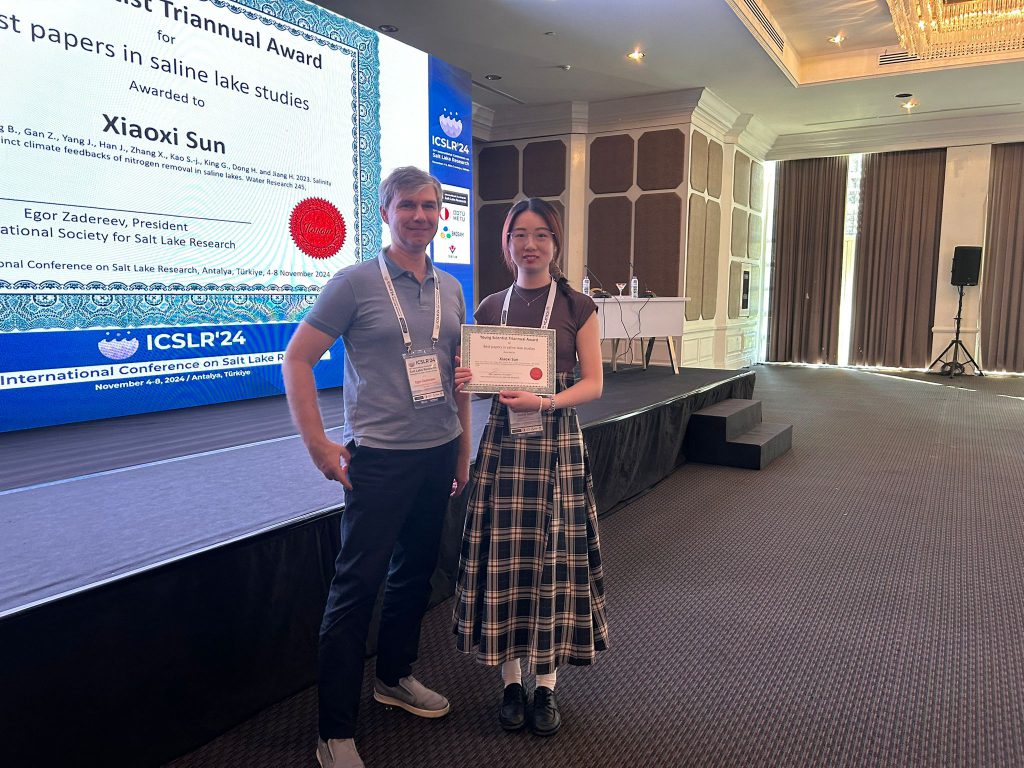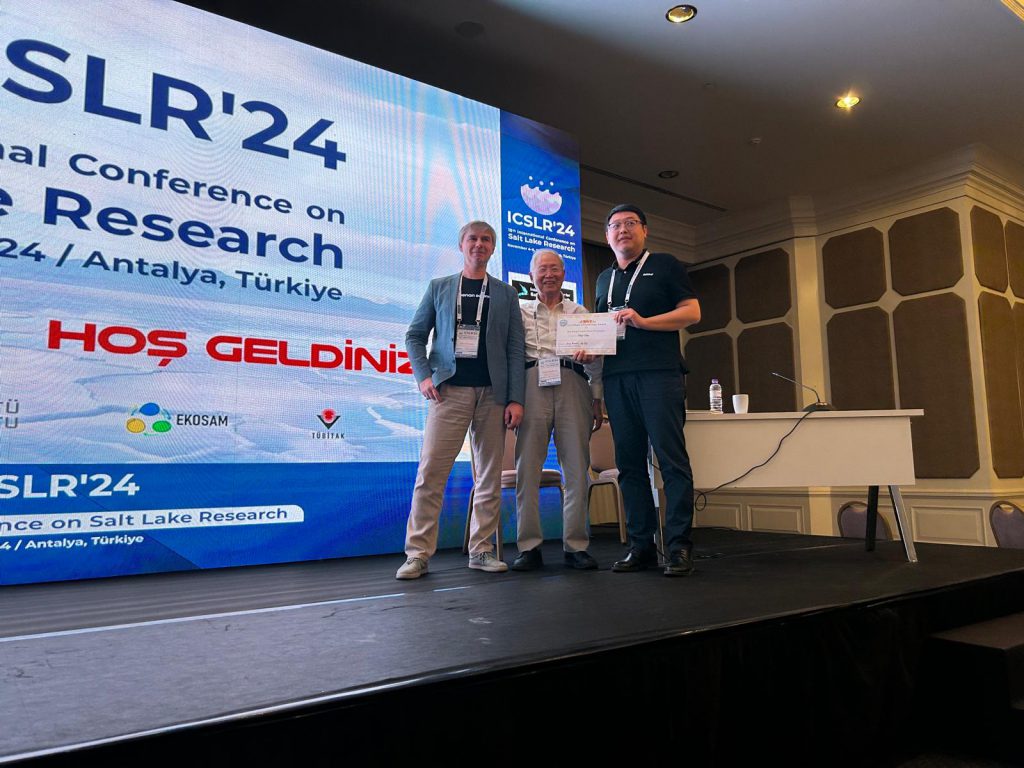The 15th International Conference on Salt Lake Research was held during 4-8 November. The conference was organized by the International Society for Salt Lake Research (ISSLR) together with the Centre for Ecosystem Research and Implementation, Middle East Technical University (METU, Ankara) and supported by the TÜBİTAK Scientist Support Programs Directorate (BİDEB) under Türkiye’s 2223-B National Scientific Event Organization Support Program. Technical support was provided by Arber Co., a firm specialized in conference organization.
The conference was attended by 112 scientists from 15 different countries. There were 6 plenary talks, 63 oral presentations and 30 poster presentations. The major topics covered were: geological history and paleoecology of saline lakes; physical-chemical processes and modeling of saline lakes; structure, functioning and dynamics of saline lake ecosystems; impact of desalination and freshwater salinization on ecosystem structure and functioning; impact of climate change and land use on the ecology of saline lakes; biodiversity and conservation of saline lakes and adjacent habitats; economic and social values of saline lakes and impacts of resource (e.g. brine, Artemia, etc.) extraction; management and restoration of saline lakes and related watersheds; and others.

The word analysis of talk’s titles presented at the conference revealed 608 unique words. The top-20 of the most frequently used unique words (Figure 1) demonstrated that they could be divided into 4 categories: those related to lake itself (blue in the figure – words: Lake, Lakes, Water, Shallow), “salinity” (black – words: Salt, Salinity, Saline, Lithium), “geography” (orange – words: Sea, Plateau, Great, Basin, Coastal) and “Ecology” (green – words: Diversity, Mesocosm, Synchronized, Climate, Effects, Experiment, Community).
Plenary presentations
Erik Jeppesen (Denmark) opened the conference with the overview talk on the impact of water abstraction and global warming on water balance, salinity, and lake ecosystems in arid and semi-arid regions. He made a special focus on Turkish lakes to highlight the results of a 4-year TÜBITAK project CLIM-SALTLAKES that studied the climate change effects on trophic structure and dynamics in saline and brackish lakes. In this project scientists have: 1) established internationally unique well-equipped experimental facilities at METU at the Ankara and Mersin campuses, allowing comprehensive studies of stressors effects on complex lake ecosystems at each place individually or synchronized between the two climate regions; 2) conducted three comprehensive highly synchronized experiments at these facilities (a saline gradient effect study and studies of the effects of short- and long-term heatwaves crossed with low and high salinities; 3) conducted a comprehensive snap-shot study of 50 inland and coastal saline lakes in Türkiye (63 sites) and 15 inland saline lakes (29 sites) in Kazakhstan; 4) done remote sensing and modelling studies of the changes in water balance and size taken place in the past 40 years and predicted the future for lakes in the Konya and Burdur closed basins.
Masoud Tajrishy (Iran) presented the story of Urmia Lake restoration: from challenges to solutions. Significant efforts were made during the last ten years to reverse the trend of water level decline in Urmia Lake. Some positive results were achieved but inconsistency in governance may jeopardize the gains made.
Lynn de Freitas (USA) presented the story of a nonprofit membership organization FRIENDS of Great Salt Lake. The mission of this NGO is to preserve and protect the Great Salt Lake ecosystem and to raise public awareness about the Lake through education, research, advocacy, and the arts. In November 2022, Great Salt Lake set a new historic record low elevation of 4,188.5’ asl. The diminished ecological viability of the system, toxic dust from the exposed lake bed blowing over populated areas, and negative impacts to the lake’s resources prompted a significant, positive shift in public and political attitudes towards the Lake. That shift has translated into a willingness to dedicate considerable resources and actions to address its decline.
Tamas Felfoldi (Hungary) presentation was focused on microbes of soda lakes. Soda lakes often have multiple extreme environments with special ionic composition, alkaline pH, high turbidity, humic material and nutrient content, special underwater light-limited environment, and have rapid fluctuations of the physico-chemical conditions. He focused on the role of microorganisms (bacteria, algae and protists) in these habitats based on studies conducted with his research group in the recent years including both cultivation-based and environmental DNA-based results, mainly focusing on the soda lakes and pans of the Pannonian Basin in Central Europe. Local phenomena (such as algal blooms, effect of desiccation) and global microbiome data from saline lakes, furthermore several aspects of microbial ecology, such as adaptation and biological interactions were discussed.
Panel discussions
There were two panel discussions organized for all conference participants.
The discussion, “Solutions for Shrinking Saline Lakes,” was chaired by Bonnie Baxter (Director, Great Salt Lake Institute, Westminster University, USA) and featured a program designed by Georgie Corkery (Coordinator, Great Salt Lake Institute, Westminster University, USA), Massoud Tajrishy (Professor, Sharif University of Technology) and his student, Mahya Alavi. This panel harnessed the collective expertise of conference participants, each bringing a deep understanding of the ecological systems they study and the social dynamics that either support or hinder efforts to preserve these systems at risk of collapse. The primary goal was to gather insights on the critical challenges facing saline lakes. To achieve this, a live poll was conducted, inviting participants to identify the issues affecting their respective saline systems, prioritize these issues by importance, evaluate the impact of policies and legal decision-making processes, and share technologies—whether successful or not—that have been implemented to improve their systems. The poll consisted of 18 questions and had 52 participants who together represented 18 countries and 46 saline ecosystems.
The panel discussion “The Role of NGO in the Study, Conservation, and Management of Saline Lakes” was co-chaired by Lynn de Freitas (Executive Director, FRIENDS of Great Salt Lake, USA) and Katia Hueso (IPAISAL Network/Comillas Pontifical University, Spain).
This panel on the role NGOs play in the conservation of the natural values and cultural heritage of saline lakes and surrounding landscapes, volunteerism, restoration of saltworks for environmental, cultural, and social purposes as well as activism against the environmental degradation of these sites. NGOs are essential stakeholders that function as a bridge between science, policy, and society. NGOs have the capacity to understand and apply research outcomes, collaborate with academia, and stimulate citizen science, helping translate scientific results to decision-makers and the public at large. Thanks to the close ties NGOs have with local communities, they can mobilize them into action and are perceived as free from political bias with respect to conservation issues. The goal of this panel was to exchange good practices, address environmental challenges faced by saline lakes, and establish ties between the NGO networks and ISSLR.
Participant NGOs in the panel were the Friends of the Great Salt Lake (FOGSL) and Grow the Flow Utah, from the USA; the Coorong Environmental Trust, from Australia; Beijing DZG Science and Technology, from China and the IPAISAL Network from Spain. Of course, all participants -including the public- were also representing the ISSLR. The panel pivoted around questions that the NGOs present replied to in turns. These questions were:
- What are the environmental and social challenges relating to your work? (affecting the system, on the one hand; affecting your work, on the other)
The environmental challenges are related to the size and scale of the problems these systems have in certain regions, such as the Great Salt Lake or Qinghai lake. From the social point of view, lack of trust from the public was highlighted by several participants. For some, it was difficult to make the public understand there were no hidden interests.
- What do you consider your biggest outreach challenges in the work that you do? Are you impacting society, science or policy makers (diverse levels of government)?
There was a strong divide between NGOs and science. Scientists disseminate their work, independently from NGOs and do not benefit from their capacity to reach out to a broader public. It was emphasized that either mainstream scientists or NGOs do not utilize citizen science sufficiently. Decision makers and companies may politely listen to NGOs but do not apply the recommendations unless forced to. Finally, it was stressed that NGOs should keep their independence from government and other stakeholders. They should have a clean and clear voice, especially when the issues become controversial.
- What are the obstacles (e.g., costs) of participating in conferences, seminars, etc. on a local, regional or international scale? Would that help improve your work?
The main constraints identified were lack of time and financial resources. NGOs have limited availability of staff, who are often volunteers, and cannot afford to spend a few days at a conference. The costs to attend a conference are also too high. Ideally, the participation of NGOs can be concentrated in sessions relevant to them.
Awards for young scientists
ISSLR is supporting young scientists by providing awards to best papers, whose authors are then invited to present a plenary talk during the upcoming conference. This year’s winners of the Best Paper Award were:
Dr. Jianrong Huang (China) with her publication: Huang J, Yang J, Han M, Wang B, Sun X, Jiang H. Microbial carbon fixation and its influencing factors in saline lake water (2023). Science of the Total Environment, 877:162922.

Dr. Xiaoxi Sun (China) with her publication: Sun, X., Tan, E., Wang, B., Gan, Z., Yang, J., Han, J., Zhang, X., Kao, S.-j., King, G., Dong, H. and Jiang, H. (2023) Salinity change induces distinct climate feedbacks of nitrogen removal in saline lakes. Water Research 245, 120668.

Also, young scientists competed for the Bill Williams Award for the best oral and poster presentation. The winners of this conference were:
- Anna McEntire (USA) with her oral presentation “Toxic dust storms” or “Thriving ecosystem”: Examining public attitudes, values, and concerns of Great Salt Lake (Utah, USA)”

- Polina Len (Kazakhstan) with her poster presentation “Diversity and distribution of bacterioplankton community across the depth and thermal gradients in Chernyshev Bay, former Aral Sea basin”

In addition, the Salinolgy awards for best oral and poster talks were sponsored by the vice-president of the ISSLR, Academician Mianping Zheng. Salinology awards were given to:
- Best Oral talk by Kaiyu Zhao (China) with the title “Green and Efficient Lithium Extraction from Salt Lake Brines”

- Best Poster talk by Caroline Hung (USA) with the title “Unraveling the Sulfur Mass Balance in the Rapidly Evolving Salton Sea Evaporitic System”
General ISSLR members meeting
At the end of the conference, the General Meeting of members of the International Society for Salt Lake Research was organized. Reports by the President (Egor Zadereev), Secretary/Treasurer (Wayne Wurtsbaugh), and Editor (Tianlong Deng) were presented and approved by society members. Several nominations were made for the new ISSLR Board of Directors (to be elected at the beginning of the 2025), also several proposals were made to host the next ISSLR conference in 2027 (Adelaide, Australia; Yuncheng, China; Qinghai Province, China; China University of Geosciences in Wuhan, and; Nazarbayev University, Astana, Kazakhstan).
Join the society before the end of year 2024 to take part in the elections of the new Board of Directors and enjoy the community of salt lakes lovers!
